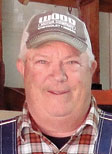 An Alabama furniture craftsman raised in a Chicago suburb got his introduction to agriculture by trading a piece of furniture for six dairy bull calves.
An Alabama furniture craftsman raised in a Chicago suburb got his introduction to agriculture by trading a piece of furniture for six dairy bull calves.
He hogtied them and wrestled the fussy, just weaned calves into the back of his pickup, transporting them to a fenced area around the furniture wood shop. Now, many years and lessons later, Randy Stull owns 70 acres and leases 300 more in Alpena, Ark., on which he runs a commercial cattle herd, as well as turkey houses.
One of his agricultural lessons occurred in 2006 when Randy was feeding his cattle using a bucket to fill a bunk when he got trapped between two cows. As soon as he was able, he crawled under the bunk for protection trying to catch his breath. He knew he was hurt but had only his dog with him. When the cattle finished feeding, he crawled out, got into his truck and went to the nearest hospital. Several hours later, he was sent home with pain pills and the information that he had broken the cartilage between his sternum and ribs. Randy said,
“Back then we had as much insurance as we could afford, but our insurance only paid about a third of the bill,” he recalled.
“That was a God driven experience because it led to a whole new business for us and help for others,” Cathy, Randy’s wife, added.
Farm safety is always in the forefront of everyone involved in agriculture. The more Randy thought about his accident, the more convinced he became that there had to be a way to build a practical and safe gravity flow manual feeder that fit on the back of an ATV. It needed to be strong but lightweight, which meant 16-gauge steel, and it had to have a universal mount for all brands of ATVs. Adjustments to the prototype were made on the chute angle for flow efficiency and the addition of an attached toolbox under the sloped floor to make up for the lost accessibility at the back of the ATV. Randy also decided to ship the feeder in pieces to be assembled on-site so the product could be shipped by UPS. Shipping in pieces saves expensive motor freight shipping charges.
“The people who buy this tend to be handy and have no assembly difficulty,” Randy explained.
Randy will never forget an elderly couple who came to the first day of Farm Fest in Springfield, Mo. They looked at the feeders, which the wife was in favor of purchasing then and there. The husband, however, didn’t believe the feeder was necessary. On the last day of Farm Fest, the same couple came back with the husband in a wheelchair because a cow had stepped on his foot and broken it while he was filling his bunk. Needless to say, the couple bought the feeder.
“I have many stories like that but fortunately most of my customers understand the safety advantage ahead of time,” Randy said.
As a result of his accident and increased awareness of safety, his business is now listed with Farmers with Disabilities in several states. The business incorporated in 2008 for liability protection and tax advantages with the motto: “Peaceful, Easy Feedin.”
The feeders come in four capacity sizes, 200 pounds and 400 pounds, which are gravity flow; and 600 pounds, which is auger fed; and a new 500-pound live bottom or drag chain bottom model debuting this summer that is designed to handle the new, larger cubes on the market.
“Even though I have cattle and turkeys, the development of this feeder business goes back to the joy I felt as a kid when I played with an erector set,” Randy said.
Randy’s love of tinkering also extends to his farming. Although he has raised more than 2.5 million turkeys for Butterball, he likes tinkering with genetics in his commercial cow/calf operation.
When he started, Randy raised Charolais and then went to Black Limousin bulls to change the color. He now uses Red Angus bulls because he believes blond calves bring a good price of age and the Charlois bloodlines still run strong with 75 percent of his calves being blond. He weans his calves at 6 to 7 months, with an average weight of 600 to 650 pounds, preconditioning them with vaccinations, worming and protein grain. He sells the calves as yearlings.
“I don’t sell at weaning because I have enough room and hay to support them until they’re yearlings,” Randy explained.
Cathy admitted she still has a lot of the “city” in her, but does like the country life.
“We met and married in the Chicago suburbs, and I still have a lot of the city in me. I’m not as involved with farming as much as Randy might like, but I’m proud of him and appreciate the life we live,” she said.
The couple has two children, four grandchildren and one great-grandchild.
One of the joys of their lives is sharing as much time as possible with their family and teaching their grandchildren about country life.







